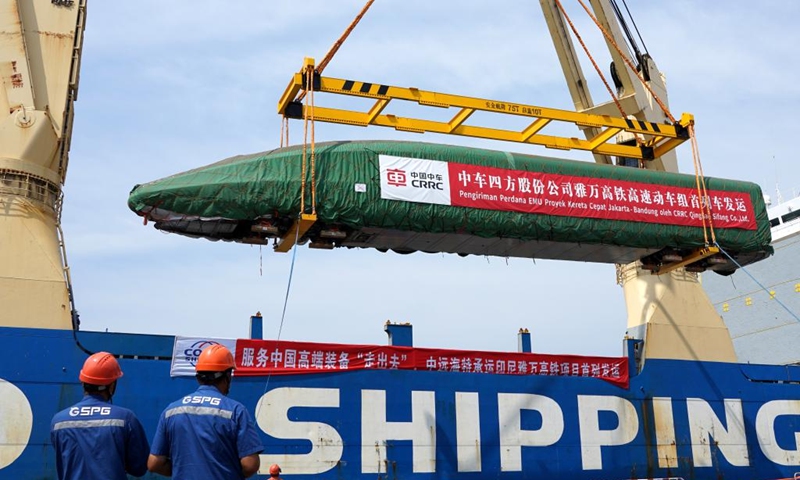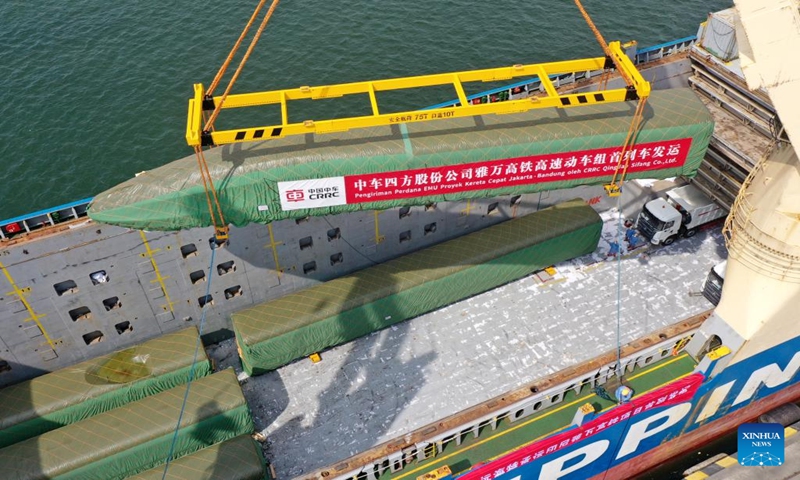China begins shipment of 350 km/h high-speed trains to Indonesia; overseas railway project provides new momentum to BRI

Photo taken on Aug. 18, 2022 shows a high-speed electric passenger train, customized for the Jakarta-Bandung High-Speed Railway, being loaded on a vessel in Qingdao Port of East China's Shandong Province. Photo: Xinhua
The first shipment of speed railway trains for the Jakarta-Bandung High Speed Railway (HSR) started on Sunday, marking important progress in the construction of the railway, a landmark project under the Belt and Road Initiative (BRI) and the export of Chinese technology, standards and equipment.
A set of high-speed electric passenger trains and a testing train, departed Qingdao port in East China's Shandong Province on Sunday and are set to arrive in Indonesia by the end of August.
The high-speed electric multiple units (EMUs) are expected to arrive at the port of Jakarta by the end of this month and then be transported to Bandung by road, with the rest scheduled to be shipped in batches by early 2023, a Qingdao-based source told the Global Times on Monday.
The bullet trains which will be used for the Jakarta-Bandung HSR project include 11 sets of high-speed EMUs and one comprehensive testing train, according to a statement previously sent from China Railway to the Global Times.
A manager at COSCO Shipping confirmed with the Global Times that the bullet trains bound for Jakarta-Bandung HSR will be transported by the company using specialized ships.
"COSCO has rich experience in transporting large-scale vehicles. We have transported trains for metro rail use to many countries. And there are no technical differences and difficulties for transporting high-speed bullet trains," the manager said.
Depending on the locomotive base, different gasket plans are developed. Specific locomotive lifting and unloading methods are required to avoid collisions. In addition, using scientific calculation is a safety guarantee for ocean shipping of locomotives, according to the manager.

Photo taken on Aug. 18, 2022 shows a high-speed electric passenger train, customized for the Jakarta-Bandung High-Speed Railway, being loaded on a vessel in Qingdao Port of East China's Shandong Province. Photo: Xinhua
With a total length of 142 kilometers, the Jakarta-Bandung HSR connects Jakarta, the Indonesian capital, and Bandung, a famous tourist city in Indonesia. When completed, it will be the first high-speed railway in Indonesia and Southeast Asia.
The railway project is expected to be completed in June 2023, Xinhua News Agency reported. The designed speed of 350 kilometers per hour will shorten the travel time between Jakarta and Bandung, from more than three hours to about 40 minutes.
Chinese Standards
The Jakarta-Bandung HSR is a landmark project in the construction of the BRI and the practical cooperation between China and Indonesia. It is also the first high-speed railway project launched overseas that fully uses Chinese technology, standards and equipment while being adapted to the local operational environment and line conditions in Indonesia.
The railway has adopted a number of Chinese standards. For example, as part of its core technologies, the railway system uses CTCS level 3 train control system which is independently developed by China. Working as the brain and central nerves of the high-speed train, the system can realize two-way information transmission between the vehicle and the station through wireless communication network, control the speed and dual way operation.
In addition, the EMUs are integrated with Indonesian culture and adapted to local environment. They are tailor-made for the Jakarta-Bandung HSR, CRRC Qingdao Sifang Rolling Stock Research Institute (CRRC SRI) told the Global Times.
CRRC SRI has provided a number of core system products, including a fire monitoring system, the braking system and anti-vibration system, for the EMUs for Jakarta-Bandung HSR.
The integration of all Chinese standards and local elements marks a new stage in the overseas strategy for Chinese manufacturing, Chinese technology and Chinese standards, Chen Jia, an independent research fellow told the Global Times on Monday.
Compared with the traditional model which is mainly based on products and services and financial investment, under this model, Chinese companies will not only introduce advanced technologies to other countries, but also empower the countries to upgrade their industrial chain and develop local talent, Chen said.
As the length of high-speed railways in China is already near its likely peak, the overseas market will be a new opportunity for Chinese railway and systems, Chen said, noting that countries and regions with underdeveloped infrastructure investment will be key potential markets.
Landmark for made-in-China
The Jakarta-Bandung HSR is of demonstration significance for China's railway manufacturing equipment to go overseas, Bo Wenxi, chief economist at wealth management firm IPG China, told the Global Times on Monday.
"It will promote China's export of high-end complete mechanical and electronic products, engineering consultancy service, and rated investment and construction to overseas. On the other hand, it will increase the world's recognition of China's high-speed rail and its service and standards, Bo said.
In particular, the project has set a good example for future export of Chinese major engineering projects along the BRI and the prosperity it bought to Indonesia will have a demonstration effect on other southeast Asian countries, which are potential buyers of Chinese trains and railway systems, Zhao Gancheng, a research fellow at the Shanghai Institute for International Studies, told the Global Times on Monday.
As Indonesia's first high-speed railway, the logistics and transportation efficiency between Jakarta and Bandung will greatly improve after its opens, which will help create jobs, attract investment, boost tourism and better drive the economic development of the regions along the route, Zhao said.
The substantial progress of the railway project despite the setbacks of the epidemic also proves the strength of China in infrastructure construction and a good foundation for economic and trade cooperation between China and ASEAN, Zhao said.
A BRI showcase
In recent years, Chinese railway technology has been going global at a rapid speed. Projects involving Chinese railway are seen in Asia, Europe, North America and Africa, becoming a name brand for Belt and Road cooperation and international industrial capacity cooperation.
For example, the Mombasa-Nairobi Standard Gauge Railway (SGR) has become a booster to Kenya's socio-economic development and the improvement of local livelihoods.
According to a preliminary estimate, it will contribute over 2 percent to Kenya's GDP. The railway project has created nearly 50,000 jobs in Kenya, and for the vast majority of those jobs, over 80 percent of their employees are locals, according to Wang Wenbin, spokesperson for Chinese foreign ministry in comments made on August 11.
The China-Laos Railway is another case in point. During its construction, the railway created more than 110,000 local jobs and the Chinese side helped build around 2,000 km of roads and canals along the railway and over 5.1 billion yuan ($745 million) worth of materials and supplies were purchased from Laos.
These inspiring stories of the success of Chinese railway in many parts of the world indicate that global development will only flourish if we all join together and foster a development paradigm featuring benefits for all, balance, coordination, inclusiveness, win-win cooperation and common prosperity, Wang said.
Infograhpic on page 10 雅万高铁建设时间线
Timeline of Jakarta-Bandung High-Speed Railway
2016 Jan 21 Construction started
2022 Jun 21 Construction of all 13 tunnels finished
2023 Jun Expected completion
Source: Xinhua News Agency
新华社雅加达1月22日电(郑世波)印度尼西亚雅加达至万隆(雅万)高速铁路21日开工建设,印尼媒体高度评价这一项目,认为雅万高铁是印尼公共和铁路交通的重大升级,将带动相关行业发展,提高地区经济发展水平。
http://www.gov.cn/xinwen/2016-01/22/content_5035395.htm
All 13 tunnels of Jakarta-Bandung High-Speed Railway completed
https://english.news.cn/asiapacific/20220621/ff450837e76546859ec867377f7ad1b8/c.html
网稿图 caption:
Aerial photo taken on June 29, 2022 shows the construction site of bridge deck ancillary works from No.4 casting yard to Tegal Luar Station of the Jakarta-Bandung High-Speed Railway in Indonesia. Photo: Xinhua
Aerial photo taken on June 24, 2022 shows the lifting of the last box girder of No.1 casting yard of the Jakarta-Bandung High-Speed Railway in Bekasi, Indonesia. Photo: Xinhua



